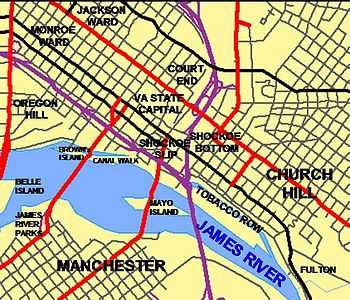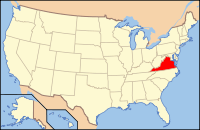Oregon Hill
- For the community in California formerly called Oregon Hill, see Greenville, Yuba County, California
|
Oregon Hill Historic District | |
 | |
|
view down Laurel Street in Oregon Hill | |
| Location | Roughly bounded by W. Cary St., Belvidere St., Oregon Hill Park, S. Cherry St. and S. Linden St., Richmond, Virginia |
|---|---|
| Coordinates | 37°32′24″N 77°27′7″W / 37.54000°N 77.45194°W |
| Area | 84 acres (34 ha) |
| Architect | Noland & Baskervill; Martin, Baylor S. |
| Architectural style | Late 19th And 20th Century Revivals, Late Victorian, Federal |
| Governing body | State |
| NRHP Reference # |
91000022 [1] |
| VLR # | 127-0362 |
| Significant dates | |
| Added to NRHP | February 05, 1991 |
| Designated VLR | December 11, 1990[2] |

Oregon Hill is a historic white working-class neighborhood in Richmond, Virginia. Oregon Hill overlooks the James River and Belle Isle, and provides access to Hollywood Cemetery. Due to the neighborhoods proximity to the Monroe Park Campus of Virginia Commonwealth University, the neighborhood is sometimes referred to as a student quarter because of its high college student population.[3]
William Byrd III established a rural estate on the property in 1758. Wealthy heiress Grace Arents helped build many institutions to serve the community.[4]
History
In 1758, William Byrd III built his country house Belvidere on this hill, with views of the James River as well as Church Hill (Richmond, Virginia) and Shockoe Hill. Fire destroyed the house and gardens about a century later, by which time the neighborhood had transformed from an agricultural to industrial one. Construction of the James River and Kanawha Canal beginning in 1785 brought not only boatman, but merchants, millers and iron workers to the neighborhood.
Important Quakers who lived in the Oregon Hill neighborhood included Robert Pleasants,[5] and later Samuel Pleasants Parsons, who became superintendent of the Virginia Penitentiary, which once stood on Belvidere Street. As General Superintendent of the canal company, Parsons oversaw its expansion to Lynchburg, Virginia.[6] In 1817, the Harvie family, which owned most of the neighborhood, subdivided it into lots, which were sold to blacks as well as whites. The Baker House, built by a "free person of color" on Belvidere Street circa 1850, was moved in the 1920s to 617 Cherry Street.[7] The neighborhood's name refers to quips that employees moving there to be close to their workplace might as well be moving westward to Oregon. The Tredegar Iron Works and Albemarle Paper Company became major employers by the 1850s. In 1849, the Hollywood Cemetery was developed from what had been known as Harvie's Woods at the edge of the neighborhood.
Most early buildings in the current historic district date from industrial expansion during Reconstruction following the Civil War, when state office buildings also replaced some single-family housing. Richmond annexed the neighborhood in 1869. The oldest surviving church building is the Pine Street Baptist Church,[8] built in 1886. The city acquired the land which became Riverside Park, delimiting the neighborhood's southern edge, in 1889. The park keeper's house dates from 1900, but many of the walkways and other buildings were constructed by the Works Progress Administration in the 1930s. The park sustained substantial damage from tropical storm Gaston in 2007.
St. Andrew's Church started as a Sunday school mission of St. Paul's Episcopal Church in 1873. A brick structure replaced the original wood frame building in 1901.[9] In 1894, Richmond philanthropist Miss Gracie Arents (niece of Lewis Ginter) established a kindergarten, which later expanded into St. Andrews School, and ultimately the St. Andrew's Church Complex. Around the same time, Sadie Heath Cabaniss, superintendent of the nursing school at Old Dominion Hospital (now VCU School of Nursing), founded the Nurse's Settlement House, now known as the William Byrd Center.[10] All three continue to the current day, with separate but complementary missions among the neighborhood's (and metropolitan area's) working families.
Oregon Hill Today
Oregon Hill is currently bordered by Cary St. to the north, Belvidere St. to the east, The James River and Canal to the south, and by the Hollywood cemetery and Linden St. to the west. It is located only a few blocks south of Virginia Commonwealth University. With generally low-rent dwellings, it is a popular place for students to rent houses or apartments. It is also known as a white working class enclave. Recently, there has been much development throughout Oregon Hill. This development has occurred in several forms. Infill projects have erected houses in lots that were previously vacant due to fires or other demolition. Many old buildings have either been torn down and replaced with townhouses, or renovated. As of 2007, a new townhouse complex called "The Overlook" has been mostly completed and inhabited on the blocks overlooking the James River. Possibly one of the most important sites in this neighborhood is "Moss's House." Restaurants in the area include "Mojo's Philadelphia Cheese Steak", and the iconic "Mamma 'Zu". Up until the 1990s, original housing stock stood on and was inhabited in this area. It was demolished and the land stood vacant after 1997, during which time it was used as a riverside park overlooking the James. The complete demolition of all the houses on these 3 blocks was a source of bitter contention between the neighborhood and the Ethyl Corporation, which owned the land. Some original houses still look over the river to the west of this development. Due to the major development, and the accompanying rise in property taxes and general cost of living, many families who have lived in Oregon Hill for generations are selling their homes or finding their rents unaffordable.
Oregon Hill in Popular Culture
In 1992, the country/rock band Cowboy Junkies released a song titled Oregon Hill, which features a description of the neighborhood. Avail, a punk/hardcore band based out of Richmond, often talks of Oregon Hill. The Oregon Hill area also serves as backdrop for Harbor on the Hill, a dystopian adventure novel published in 2011.
Maps
References
- ↑ "National Register Information System". National Register of Historic Places. National Park Service. 2009-03-13.
- ↑ "Virginia Landmarks Register". Virginia Department of Historic Resources. Retrieved 19 March 2013.
- ↑ Larter, David (January 8, 2013). "Victory for Oregon Hill apartments plan". Richmond Biz Sense. RichmondBizSense.com. Retrieved February 8, 2013.
- ↑ Oregon Hill National Park Service
- ↑ http://www.dhr.virginia.gov/hiway_markers/marker.cfm?mid=4378
- ↑ http://www.vacanals.org/2012/09/07/historic-canal-in-richmond-in-danger-of-being-destroyed-by-ampitheater/
- ↑ http://www.nps.gov/nr/travel/richmond/OregonHillHD.html
- ↑ http://pinestbaptist.com/
- ↑ http://standrewsoregonhill.org/pages/page.asp?page_id=115976
- ↑ http://www.wbch.org/?page_id=151
External links
- Maurice Duke oral history with section on Oregon Hill
- Oregon Hill: Best View in the City, Commonwealth Times April 30, 1976 by Donna Pugh
- Richmond Architectural Survey Collection 277 photographs and architectural surveys from the mid-1970s. VCU Libraries.
- Oregon Hill neighbors on Yahoo!Groups
- Oregon Hill on Myspace.com
- Facebook Groups: "Friends of Oregon Hill"
Coordinates: 37°32′23″N 77°27′05″W / 37.53968°N 77.45138°W
| ||||||||||||||||||||||||||||||||||||||||||
| ||||||||||||||

